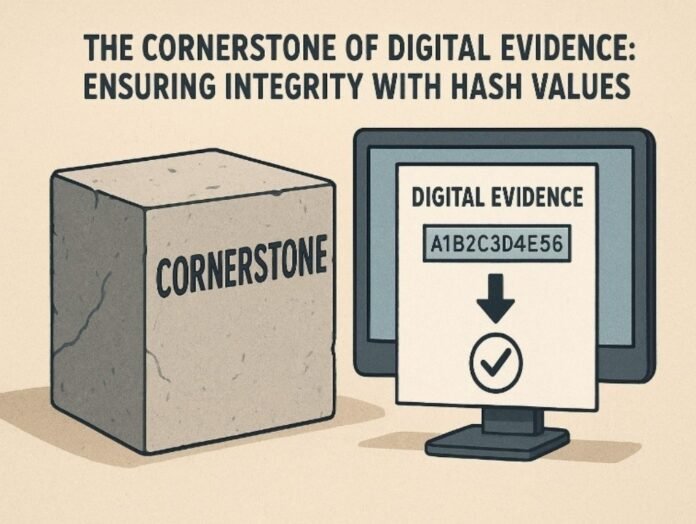Hash Values: The Cornerstone of Digital Forensics
In today’s digital age, information is everywhere—stored in smartphones, computers, cloud servers, and countless connected devices. This information is not only central to daily life but also forms the backbone of modern criminal investigations. From CCTV footage to seized laptops, digital evidence frequently plays a decisive role in the pursuit of justice. Yet, a pressing question arises: how can we be certain that digital evidence remains untampered, unaltered, and authentic? The answer lies in hash values—the cornerstone of digital forensics.
What Is a Hash Value?
A hash value is best described as a unique digital fingerprint of a file. Generated by applying a mathematical algorithm to data, a hash produces a string of letters and numbers that uniquely represents that data. Even the smallest alteration—changing one character in a text file or modifying a single pixel in a photograph—produces an entirely different hash. This makes hashing a powerful and reliable method for proving that evidence has not been modified at any stage of the investigation.
The Role of Hash Values in Criminal Investigations
Hashing is indispensable at every stage of the evidence lifecycle—from seizure to courtroom presentation.
Collection of Evidence
When police seize digital devices (e.g., hard drives, memory cards), they do not analyze the originals directly. Instead, they create an exact bit-by-bit copy known as a forensic image. To prove that the image is a faithful duplicate, investigators generate hash values for both the original and the copy. Matching values confirm that the forensic image is an unaltered replica. This process safeguards the integrity of the original while preserving admissibility in court.
Investigation and Analysis
During analysis, hash values serve multiple purposes:
- Detecting duplicates: Two files with identical content will always share the same hash, regardless of filename.
- Filtering known data: Investigators maintain hash libraries of harmless files (e.g., operating system files), enabling quick exclusion of irrelevant data.
- Verifying transfers: Each time evidence is moved between labs or systems, hash values are recalculated to ensure no corruption or tampering has occurred.
Courtroom Authentication
When presented in court, digital evidence is often challenged. By demonstrating that the hash value of the evidence in court matches the one calculated at the time of seizure, investigators can scientifically prove authenticity. This reassures judges and juries that the evidence is original, credible, and untampered.
Judicial Recognition of Hash Values
The legal community has increasingly recognized hash values as a scientifically sound and judicially reliable method for authenticating electronic evidence.
In India, the Supreme Court in Anvar P.V. v. P.K. Basheer (2014) underscored the need for strict technical safeguards in proving electronic records, paving the way for hash verification as a reliable safeguard. In Jagdeo Singh v. State (2015), the Delhi High Court explicitly acknowledged that matching hash values ensure originality and prevent allegations of tampering. The Gujarat High Court, in State of Gujarat v. Mohanlal Jitamalji Porwal (2018), went further, affirming the central role of hash values when multiple forensic copies are produced.
In the United States, courts have consistently accepted hash values as the “digital fingerprints” of files. In United States v. Cartier (2008), the Eighth Circuit validated forensic evidence authenticated through hash matching. Similarly, in United States v. Wellman (2011), the Fourth Circuit recognized hash values as a scientifically reliable method of proof. More recently, United States v. Grant (2022) reinforced the principle that forensic copies authenticated by hash verification are admissible in court.
In the United Kingdom, cases like R v. Blackburn (2005) accepted hash values as reliable markers of authenticity in criminal proceedings involving digital images, while earlier rulings such as R v. Fellows and Arnold (1997) paved the way for recognizing technological safeguards in proving electronic records.
These judicial acknowledgments confirm that hash values are not only technical safeguards but also legally validated tools—trusted across jurisdictions.
Why Hash Values Are Critical
In an era dominated by digital evidence, trust in integrity is paramount. Hashing ensures transparency and reliability, making it a cornerstone of digital justice systems worldwide. In the United States and India, courts now routinely accept hash values as reliable proof of authenticity. Internationally, forensic standards emphasize hashing as a mandatory safeguard in handling electronic evidence.
Golden Rules for Handling Digital Evidence
To maximize the effectiveness of hash values, strict protocols must be followed:
- Use strong algorithms: Secure algorithms like SHA-256 are the current standard. Older algorithms such as MD5 or SHA-1 are prone to collisions and are discouraged.
- Maintain complete documentation: Every hash value must be meticulously recorded to preserve the chain of custody. This log is often as important as the evidence itself.
- Ensure proper training: Investigators must be proficient in handling, hashing, and documenting digital evidence to avoid errors that could render evidence inadmissible.
Forensic Imaging — Preserving the Digital Truth
Creating a forensic image is one of the most critical steps in digital evidence handling. It involves:
- Write-blocking the original: Prevents the operating system from unintentionally altering data when accessing a drive. Write blocking can be achieved through:
- Hardware write blocker: A physical device placed between the computer and the evidence to allow only reading.
- Software write blocker: A program that stops the computer from writing anything to the evidence.
Hardware blockers are considered more reliable in courts, while software blockers are cheaper and easier to use but may not always be as secure.
- Bit-by-bit cloning: Copies every sector of the device, including deleted files, hidden partitions, and unused space.
- Hash verification: Confirms that the forensic image is an exact duplicate by comparing hash values of the original and the copy.
This meticulous process ensures that digital evidence remains untouched and legally defensible.
Write Blocking: Practical Notes and Market Context
In India, both hardware and software write blockers are available for forensic use, but hardware ones are more common and preferred in courts. On the Government e-Marketplace (GeM), devices from brands like CRU, Logicube, Tableau (OpenText), and Digital Intelligence are listed, with prices ranging from about ₹86,500 for CRU to over ₹6 lakh for advanced Tableau and Logicube models. Import records show smaller Tableau devices like the T6U and T8U priced around ₹30,000–₹40,000, while an UltraBlock PCIe costs about ₹64,000. Software write blockers are cheaper but less relied upon; for example, the SAFE Block license costs about ₹46,000. Overall, hardware blockers are costlier but more reliable, while software options are affordable but less secure.
Calculating Hash Values with FTK Imager
FTK Imager is a widely respected program used in digital investigations, and its methods are accepted by courts. It uses powerful digital codes, like SHA-256, to create unique “fingerprints” for data.
To make a perfect digital copy of evidence using FTK Imager, the investigator first goes to the “File” menu and chooses “Create Disk Image.” They then select the original storage device they want to copy and type in details about their case.
After these steps, the software automatically takes over. It creates and then checks these unique digital fingerprints (called hashes) for both the main source of data and the new copy. All of these results are then recorded in a clear, detailed report.
This automated process is very important because it guarantees that the digital evidence is real and hasn’t been changed. This means it can be used confidently in court right from the moment it is first collected.
Case Applications
- In cyber fraud cases, hash values protect against claims of planted or altered evidence.
- In terrorism trials, forensic teams present hash reports to prove the authenticity of seized hard drives.
- In corporate investigations, employee devices are imaged and verified with hash values before HR or legal review.
Conclusion
In the digital era, where evidence is fragile and susceptible to manipulation, hash values stand as the guardians of authenticity. They transform intangible data into verifiable proof, ensuring that courts can rely on digital evidence with confidence. Judicial recognition across India, the United States, and the United Kingdom underscores their dual strength—a technical safeguard and a legally accepted standard of proof. By adhering to strong hashing practices, following strict protocols, and leveraging professional forensic tools, law enforcement agencies can build stronger cases and uphold the integrity of justice. Hash values are not just technical markers—they are the cornerstone of digital truth.


